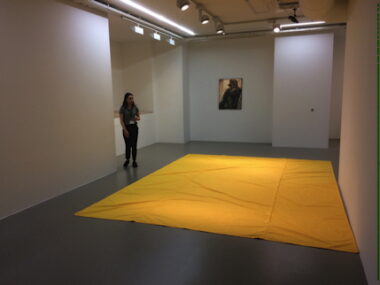Ways Of Seeing
Plato’s Allegory of the Cave is an ancient attempt to describe the psychology of perception. A group of people who have lived chained to the wall of a cave all of their lives are facing a blank wall. The people watch shadows projected on the wall from objects passing in front of a fire behind them, and give names to these shadows. The shadows are the prisoners’ reality. In Plato’s allegory Socrates explains how the philosopher is like a prisoner who is freed from the cave and comes to understand that the shadows on the wall are not reality at all, for he can perceive the true form of reality rather than the manufactured reality that is the shadows seen by the prisoners.
While looking at Ghana Amer’s painting “Sharazad” the viewers first sees the Threat markings that permeate the entire surface. Upon a closer look, the image of a woman emerges. It shows Amer’s interest in reclaiming the female nude and the common habit of tabooing or exploiting it in all cultures and art histories as well. The criticism of the patriarchal hegemony over the arts echoes John Berger’s words “To be naked is to be oneself. To be nude is to be seen naked by others and yet not recognized for oneself.”
James Casebere’s fake images of a non-existing housing in dutch-style in America is questioning the photography’s claims of truthful representation and the nightmarish living style of gated communities widely common to secure a privacy for wealth and conformism. Unpopulated and colored in weird artificial colours the images are causing an uncomfortable ambiguity highly intended by the artist.
‘Alta” (pink) by James Turrel creates the illusion of a three-dimensional object by matching the colors of the light to those of the walls and the room. The work was created in the late Sixties questioning the understanding of sculpture and space.
The unconscious was the focus of interest of surrealist artists suffering from the horrific consequences of the First World War. The sculpture was conceived by Salvador Dali and executed by Max Clarac Sérou. Unrelated objects are juxtaposed with one another. What seems to be a reference to latent sexual desires are much more representations of repressed fears.
Shana Maulton is transforming instruments to overcome disabilities into objects representing the tension between the beauty and the burden of aging. A human being, as long as he is blessed by an old age is sometimes crossing the path between maturity and insanity. A torn alphabet, a necklace and the ropes around the walkers are triggering ambigue feelings towards the reality of the late stage of being close before departing to the reality of death. The viewers approach to eternity will shape the perception of these objects. Mouton’s interpretation is beautifully inviting to an approach of hope and spiritual strength, a fine comment on what art can be if it is taken as a life school of changing perceptions over and over again.
“Ways of Seeing”, curated by Sam Bardaoil & Till Fellrath, After-İstanbul, 2 June – 13 August 2017











